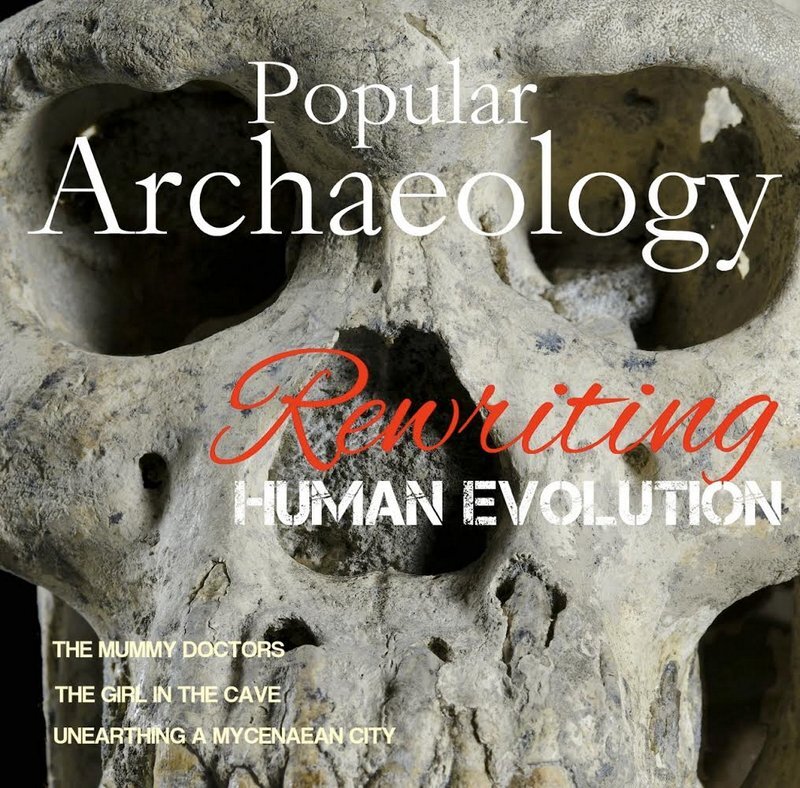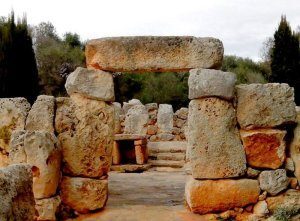
In the summer of 2015 a team of archaeologists will begin excavation of a cyclopean sanctuary located on the Mediterranean island of Menorca. This type of building is monumental and exclusive to this island, with no parallel around the world. Because of this, fieldwork at this building will offer the opportunity to both researchers and excavators to uncover a unique megalithic religious center, where they will obtain information about the ritual practices carried out there and the whole meaning of the building in relation to their users: the so-called Talayotic society.
A Recent Prehistoric Society to be Discovered…the Talayotic
The sanctuary under archaeological investigation is located at the site of Sa Cudia Cremada, a talayotic site (Bronze and Iron Age) which is located in the outskirts of the city of Mahón, the capital of the island. Fieldwork will be carried out by Sa Cudia Cremada Field School: Mediterranean Archaeology in Menorca, an organization that is calling for participants to attend courses which are scheduled for the summer of 2015 in August and September. (By joining the Field School team, participants will have the opportunity to dig in a megalithic religious center, learn proper excavation techniques, work at the laboratory and discover the archaeology that this small paradise, the island of Menorca, hides!) The team aims to carry out scientific research as well as reach out to the general public so that everybody can learn about the archaeology of Menorca (not only professionals in the field of Archaeology and academic circles, but also the general public interested in archaeology).
Menorca is the easternmost of the Balearic Islands (Spain), a beautiful Mediterranean island that attracts visitors for its stunning nature and its unique archaeology. In fact, it was declared a Reserve of the Biosphere by the UNESCO in 1993, and it is currently a candidate to become a UNESCO World Heritage site for its recent prehistoric archaeology…which is unique in the World.
More than 1500 archaeological sites have been located on the island, which has a total area of 700 km2. This means that the density of archaeological remains is that of 2 sites per one square kilometer. The vast majority of these sites date back to the Bronze and Iron Age, from a period which is known as the Talayotic, in reference to the society, the “talaiotics”, who lived on the island from approximately the 2nd millennium BC up to the conquest of the Balearics by Rome in 123 BC.
The Talayotic society was confined to Menorca and its neighbor, Majorca, and was formed by a community of indigenous peoples from the two islands. They experienced an evolution in their social organization (from a relatively egalitarian society to a hierarchized one from the beginning of the first millennium BC), although many other aspects did not change over time, such as their cyclopean construction technique, their hand-made pottery production, an economy based on farming and stock-breeding and their complex funerary rituals and practices. The funerary evidence suggests they had strong religious beliefs and took very seriously the passing into the afterlife. However, many questions have been left unanswered, partly because they left no traces of a written and spoken language.
The excavation of a cyclopean sanctuary from this past society will shed light on the lives of an island society that developed unique cultural manifestations but, at the same time, acquired some traits from other Mediterranean peoples that reached Menorca and had cultural or commercial contacts with other societies, such as Punics, Greeks and Iberians. Those contacts intensified around 500-400 BC, especially with Punics who, by that time, had a vast territory of the western Mediterranean sea under their control, including the island of Ibiza, quite close to Menorca, the northern coast of Africa and the southeast of the Iberian peninsula, among other places.
In fact, Punics hired talayotic men in order to use them as mercenaries for their troops in the Sicilian wars, against Greeks, since they were very skillful in the use of the slingshot. Since all this started, in the middle of the 1st millennium BC, Balearic slingshot warriors fought for the Punics in many battles in many parts of the Mediterranean, including the Punic Wars against Rome, and became famous all around the ancient world for being skillful and fierce fighters. Many classical writers like Pliny, Strabo. Livy or Diodorus Siculus, praised the bravery of these warriors of the Balearic Islands, and described in detail aspects of their training, use of the slingshot, tastes and even how they were paid for their services. In fact, written sources state that these warriors refused payment with money—they preferred wine and women instead. Later on, the Balearic slingshot warriors were hired by Romans, who used them as light infantry in many battles, including the civil wars from the Late Republican period.
The Archaeological Site of Sa Cudia Cremada
The archaeological site of Sa Cudia Cremada, in the vicinity of the city of Mahón, is located on rural property, where very well-preserved architectural, ethnological and archaeological elements blend in a beautiful and characteristic Minorcan landscape. Even though the area is archaeologically rich, the most distinctive part is formed by a talayotic settlement along with its necropolis. The most visible structures are three talaiots (monumental tower-shape structures) around which the rest of the structural remains are organized in the dwelling area. Hence, the name of this society derives from the word talayot, as this is its most characteristic building.
Talayots could have served several functions, such as that of watchtowers for the defense and control of the territory, controlled storage of cereals and other products by the elite of each settlement and also as symbols of prestige and power.
The site also features a hypogeum, which is an artificial cave made by the talayotics in order to bury their dead. This cave necropolis, like rest of the hypogeums on the island, has several carved columns to sustain the roof and would have served as a collective inhumation cemetery where all the inhabitants of the settlement, regardless of age, sex and social condition, were buried. Differences in social status, gender and age could be shown by means of grave goods and personal items. Inside those cemeteries some rituals took place, about which we have not found a clear explanation yet. Some practices included storing locks of hair dyed in red in containers made of bull horns, which were all usually piled in hidden corners of the caves. Also, in several of these caves many skeletons have been found with trepanated skulls, which indicate that this society practiced surgery. Even though the purpose of trepanning is still not clear, as it happens in many other cultures, the practice of drilling a hole into the cranium, or scraping off part of it, could have served to heal head wounds, release pressure for treating migraines or other cranial illnesses. However, some scholars suggest that this practice could also be related to more spiritual purposes.
However, the most important building in Sa Cudia Cremada is the taula sanctuary, where archaeological fieldwork run by the field school will take place. Despite the fact that we still do not know much about the internal structure of this building, in these buildings the main feature is usually a large monolithic standing pillar with a lintel lying on it, called taula (meaning “table” in Catalan) due to its T shape, which is usually located at the central part of the building. The building’s layout has a horse-shoe shape composed of walls with large stone blocks. Even though we do not understand its whole meaning, it can be affirmed that religious ceremonies were carried out inside the building by the community. There is a total of 32 taula sanctuaries located on the island, and the sanctuary at the site of Sa Cudia Cremada is the only one that has not been excavated.
Other elements that can be seen at the site are several large storage pits, part of the outer wall that surrounded the settlement and walls from different buildings. The surface is full of materials, both indigenous and foreign from cultures such as Punic, Greek, Iberian and Roman.
______________________________________
 One of the many beautiful natural places in Menorca.
One of the many beautiful natural places in Menorca.
________________________________
 Cales Fonts, very close to the city of Mahón.
Cales Fonts, very close to the city of Mahón.
_________________________________
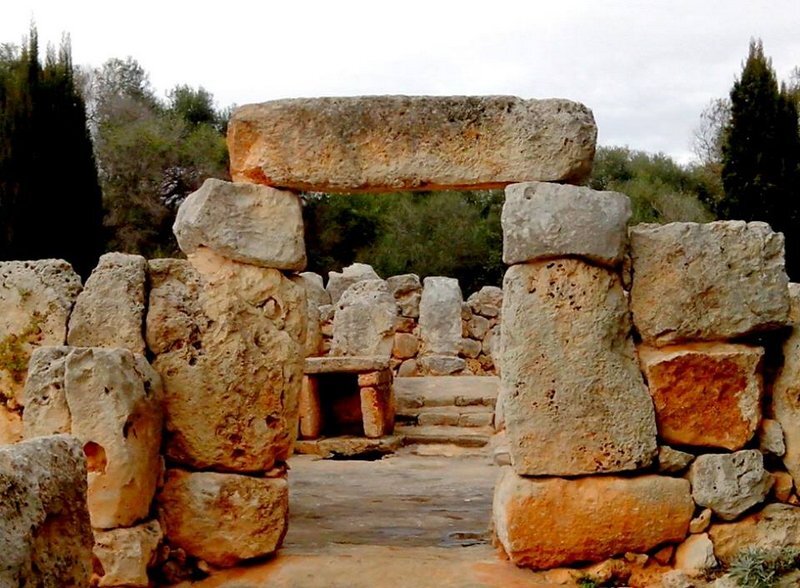 Entrance to a cyclopean talayotic house, Menorca.
Entrance to a cyclopean talayotic house, Menorca.
________________________________
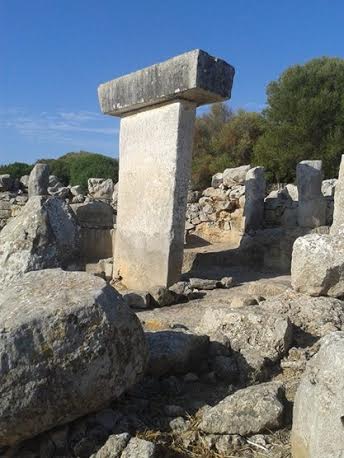 Taula monument of the site of Torralba d’en Salort, Menorca
Taula monument of the site of Torralba d’en Salort, Menorca
________________________________
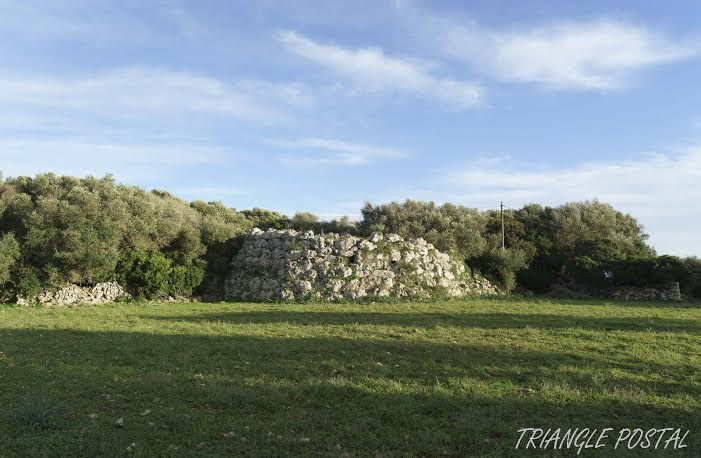 Talayot from Sa Cudia Cremada site, Menorca. Photo courtesy of Triangle Postals
Talayot from Sa Cudia Cremada site, Menorca. Photo courtesy of Triangle Postals
_________________________________
 Sanctuary from Sa Cudia Cremada site, Menorca. Photo courtesy of Triangle Postals
Sanctuary from Sa Cudia Cremada site, Menorca. Photo courtesy of Triangle Postals
_________________________________
Talayotic Beliefs
What deities did they worship inside the taula sanctuaries? What were the types of rituals that took place there? Even though little is known about the talayotic religion, thanks to the archaeological record we can be sure about some aspects of their religion, despite the fact that classical sources do not mention it and the talayotics themselves did not leave anything written or, at least, there is no evidence for that.
As in many other Mediterranean cultures, the talayotics worshipped the bull, as can be inferred by some bronze bull statuettes and bronze bull horns found in several sanctuaries. In fact, some scholars have suggested that the T-shape taula monuments were schematic representations of this animal. However, current opinions maintain that this theory lacks sufficient evidence.
Other deities worshipped by the talayotics would have been related to fertility, like a mother-earth goddess type, since they belonged to an agrarian society that depended highly on the good conditions of the land to obtain good crops for their subsistence. In relation to this cult, it is important to highlight the location of several statuettes representing the goddess Tanit in sanctuaries, which was a cult introduced to Menorca by the Punics. Tanit was the main goddess in the Carthaginian pantheon from the 5th century BC and was related to fertility as a mother goddess. This indicates how foreign contacts influenced the talayotic culture, including their beliefs.
It is also noteworthy to mention that some Egyptian objects have been found in talayotic sanctuaries, such as a bronze statuette of Imothep and another one representing Horus. How these statuettes got to the island remains unclear, although it could have happened through Punic trade. Be that as it may, the fact that they were found in sanctuaries suggests that they were considered to be special objects worth being placed inside religious spaces.
We also know about another deity that was worshipped by this society. In some sanctuaries several statuettes representing a nude warrior wearing a helmet and carrying a lance have been located. They are called Mars Balearics and are thought to be war gods that could have been produced outside the islands between the 5th and the 3rd centuries BC, probably in Etruria, although copies could have been made in the islands as well.
As for their rituals, the sanctuaries that have been already excavated have offered ash contexts around the taula monument with abundant faunal remains and pottery shards, suggesting that ceremonies took place inside the sanctuaries, which were probably related to the cult of their deities, including the ones described above. When these ceremonies happened, how they were structured, who participated in them and the purposes of those events are still unknown.
__________________________________
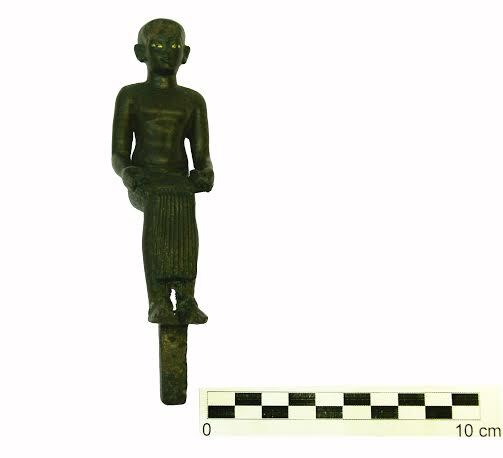 Egyptian statuette of Imhotep found in a talayotic sanctuary from Menorca.
Egyptian statuette of Imhotep found in a talayotic sanctuary from Menorca.
_______________________________
2015 Fieldwork at Sa Cudia Cremada
In 2015 the Sa Cudia Cremada Field School offers archaeological courses for participants interested in gaining first-hand experience on fieldwork and laboratory tasks. The Field School welcomes university students, professionals, as well as everybody who is interested in archaeology, ancient Mediterranean history, Bronze and Iron Age archaeology, megalithism and cultural hybridization.
2015 courses will take place in two sessions with a length of 3 weeks each in August and September, combining rigorous research with quality training for students who join the team. On course days, students will dig in the settlement’s sanctuary during the first half of the day, whereas the second part will be devoted to lectures, laboratory tasks and workshops.
The sanctuary will be excavated by using a proper field methodology. Each participant will be assigned an area to dig inside the building or in its immediate surroundings. Proper recording systems will be used and everybody will be in charge of filling out context sheets, taking photographs and drawing plans and sections.
Laboratory tasks will include the processing of all archaeological materials found on site and their correct classification, inventory and drawing. Lectures, fieldtrips and workshops will complement the course so that participants get the most out of this experience.
To know more about the Sa Cudia Cremada Field School, the site, or to sign up for their courses, you can contact the team via email at: [email protected]
You can also visit the project’s blog to read updates about the site as well as information about the talayotic culture: http://sacudiafieldschool.blogspot.com.es
_____________________________________
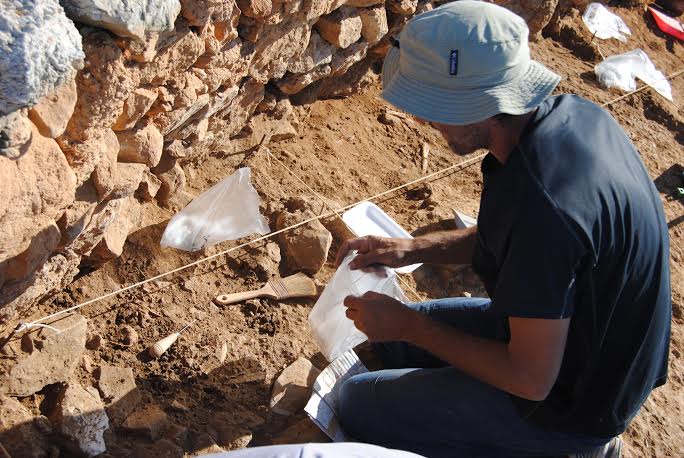 A typical scene in the field: A student carrying out fieldwork
A typical scene in the field: A student carrying out fieldwork
_____________________________________
Read about the most fascinating discoveries with a premium subscription to Popular Archaeology Magazine. Find out what Popular Archaeology Magazine is all about. AND MORE:
On the go? Get the smartphone version of Popular Archaeology as an app or as an ebook.
Just released!
The special new premium quality print edition of Popular Archaeology Magazine. A beautiful volume for the coffee table.
Travel and learn with Far Horizons.
____________________________________________
Popular Archaeology’s annual Discovery Edition eBook is a selection of the best stories published in Popular Archaeology Magazine in past issues, with an emphasis on some of the most significant, groundbreaking, or fascinating discoveries in the fields of archaeology and paleoanthropology and related fields. At least some of the articles have been updated or revised specifically for the Discovery edition. We can confidently say that there is no other single issue of an archaeology-related magazine, paper print or online, that contains as much major feature article content as this one. The latest issue, volume 2, has just been released. Go to the Discovery edition page for more information.

